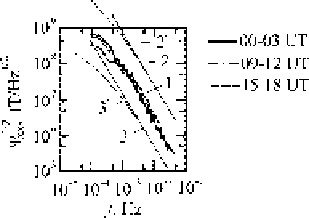Geoscience Reference
In-Depth Information
Fig. 6.14
Measured monthly average 3-h power spectra taken from Lanzerotti et al. (
1990
)
(curve 1) and calculated power spectra of magnetic noise for the nighttime (2) and daytime
(3) ionospheric parameters. The numerical calculations from improved equation (
6.107
) are shown
with lines 2
0
and 3
0
The parameters appearing in empirical Eq. (
6.103
) is chosen as follows: K
D
1 and
m
D
2. When Eq. (
6.105
) is compared with the evidence from ULF measurements
(Lanzerotti et al.
1990
), it is apparent that the spectral index n
D
1 is a best fit value.
A model calculation of the square root of the spectral amplitude with a best fit
value n
D
1 and of the power spectrum recorded at Arrival Heights, Antarctica
in June 1986 (Lanzerotti et al.
1990
) are presented in Fig.
6.14
as a function of
frequency f . The observational data taken from Lanzerotti et al. (
1990
) are shown
with line 1 while our model calculations are plotted with line 2 (daytime conditions)
and 3 (nighttime conditions). It is obvious from Fig.
6.14
that the observational
data are sandwiched between the theoretical lines 1 and 2. It should be noted that
there are some uncertainties in the ionospheric current parameters, for example, in
the constant K in Eq. (
6.104
).
We recall that 1D distribution of the ionospheric wind-driven currents results in
the 2D spectral amplitude in inverse proportion to the squared frequency, which in
turn leads to a discrepancy between the predicted and measured spectra.
The observational data slightly deviate from the straight line as is seen in the
upper corner of Fig.
6.14
. In this frequency range the correlation radius may be
greater than or equal to the distance between the Earth and the ionosphere. In such
a case the approximate solution given by Eq. (
6.89
) should be replaced by the more
accurate solution. To gain better understanding of this behavior of the observational
data, consider the case
x
D
y
D
c
.!/. Substituting Eqs. (
6.84
), (
6.87
)into
Eq. (
6.81
) and applying an inverse Bessel transform yields
1
c
.!/
exp
4d
2
1
erf
2d
c
.!/
:
0
‚.!/
32
2
1=2
d
‰
.B/
xx
.!/
D
c
.!/
(6.107)
Given the above parameters and based on Eq. (
6.107
), the numerical calculations
are shown in Fig.
6.14
with lines 2
0
and 3
0
. In the low-frequency limit, when
c
.!/
2d, the expression in square bracket tends to unity whence it follows
that ‰
.B/
xx
.!/
/
‚.!/
/
!
1
. This means that the spectral index of the power

Search WWH ::

Custom Search